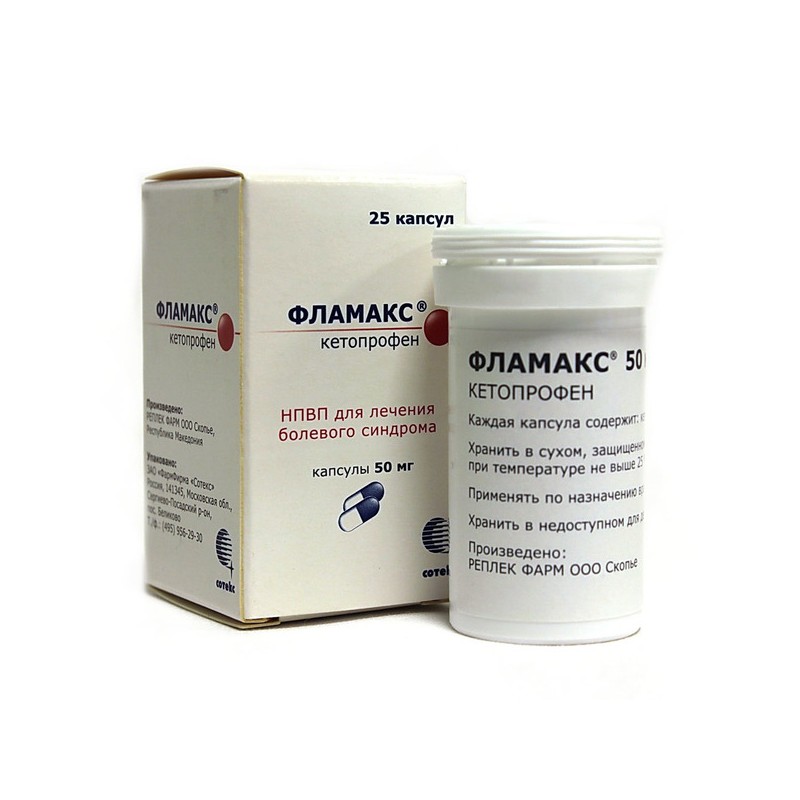




Security policy (edit with Customer reassurance module)

Delivery policy (edit with Customer reassurance module)

Return policy (edit with Customer reassurance module)
Flamax solution for intravenous and intramuscular administration:
1 amp (2 ml) contains Ketoprofen 100 mg;
Excipients: propylene glycol; ethanol (95% ethyl alcohol based on 100% substance); benzyl alcohol; sodium hydroxide; water for injections;
pack of 5 and 10 pcs.;
capsules:
1 caps contains ketoprofen 50 mg;
Excipients: lactose monohydrate; MCC; croscarmellose sodium; sodium lauryl sulfate; Povidone; colloidal silicon dioxide;
gelatin capsule composition: titanium dioxide; gelatin; Indigo Carmine FD and C Blue
in plastic containers of 25 pcs.
Flamax has an analgesic, antipyretic, anti-inflammatory, antiaggregatory effect.
Inflammatory and degenerative diseases of the musculoskeletal system, incl. rheumatoid arthritis, nonspecific spondyloarthritis (ankylosing and psoriatic spondylitis), gouty arthritis, pseudogout, osteoarthritis, extra-articular rheumatism (tendovaginitis, bursitis, capsulitis). Relief of pain syndrome of various origins, including postoperative, post-traumatic pain, sciatica, myalgia, radiculitis, bruises and muscle strains, renal colic, pain syndromes in dental, gynecological, neurological, oncological practice.Symptomatic treatment of acute pain in inflammatory diseases of the musculoskeletal system (only for IM administration). Primary dysmenorrhea.
"Aspirin" asthma, gastric ulcer and duodenal ulcer (exacerbation), ulcerative colitis (exacerbation), Crohn's disease, diverticulitis, peptic ulcer, blood coagulation disorders (including hemophilia), kidney and liver failure, children and adolescence under 18, pregnancy (III trimester).
When conducting clinical trials, the following side effects were noted (possibly related to the use of ketoprofen):
On the part of the gastrointestinal tract: dyspepsia (11%); 3–9% - nausea, abdominal pain, diarrhea / constipation, flatulence; > 1% - anorexia, vomiting, stomatitis; <1% - increased appetite, dry mouth, belching, gastritis, rectal bleeding, melena, occult bleeding, drooling, peptic ulcer, gastrointestinal perforation, hematemesis, bowel ulceration, liver dysfunction, hepatitis, cholestatic hepatitis, jaundice, excessive thirst.
From the nervous system and sensory organs: 3–9% - headache, agitation (including insomnia, nervousness, unusual dreams); > 1% - dizziness, depression of the central nervous system (including drowsiness, malaise), tinnitus, blurred vision; <1% - amnesia, confusion, migraine, paresthesia, vertigo, conjunctivitis, eye pain, hearing loss, retinal hemorrhage and change in pigmentation, taste disturbances.
From the side of the cardiovascular system and blood (blood formation, hemostasis): <1% - increased blood pressure, palpitations, tachycardia, aggravation of heart failure, peripheral vascular disease, vasodilation, hypocoagulation, agranulocytosis, anemia, hemolysis, thrombocytopenia.
On the part of the respiratory system:> 1% - dyspnea, hemoptysis, nasal bleeding, pharyngitis, rhinitis, bronchospasm, laryngeal edema.
Urogenital: 3–9% - impaired renal function (edema, increased urea nitrogen in the blood); > 1% - symptoms and signs of urinary tract irritation; <1% - menometrorrhagia, hematuria, renal failure, interstitial nephritis, nephrotic syndrome.
Dermatologic:> 1% - rash, alopecia, eczema, pruritis, urticaria, bullous rash, exfoliative dermatitis, photosensitivity, skin color changes, onycholysis, toxic epidermal necrolysis, erythema multiforme, Stevens-Johnson syndrome.
Other: <1% - chills, swelling of the face, infection, pain, allergic reactions, anaphylaxis, weight gain, hyponatremia, myalgia, purpura, increased sweating.
V / m introduction: 100 mg (1 amp.) 1-2 times a day.
In / in the infusion of Flamax should be carried out only in a hospital.
Short intravenous infusion: 100–200 mg (1–2 amp.) Of the drug diluted in 100 ml of 0.9% sodium chloride solution, injected within 0.5–1 h. Re-administration after 8 hours is possible.
Prolonged intravenous infusion: 100–200 mg (1–2 amp.) Of the drug diluted in 500 ml of the infusion solution (0.9% sodium chloride solution, lactated Ringer’s solution, 5% dextrose solution) is injected over 8 hours.
Perhaps re-introduction after 8 h.
The maximum dose is 200 mg / day.
The minimum effective dose should be used with the shortest possible short course.
Flamax capsules. Inside, during the meal. With rheumatic diseases - 1 caps. in the morning, 1 in the afternoon and 2 in the evening or 1 caps each. 4 times a day. Perhaps the combined use of dosage forms.
In patients with renal insufficiency, the dose is reduced to 33–50%; in elderly patients, the dose is adapted to age.
In the treatment of pain and algomenorrhea, the dose, if necessary, is 25-50 mg ketoprofen every 6-8 hours.
The maximum daily dose is 300 mg.
Store in a cool and dark place, protected from light and moisture, at a temperature not higher than 25 ° C.